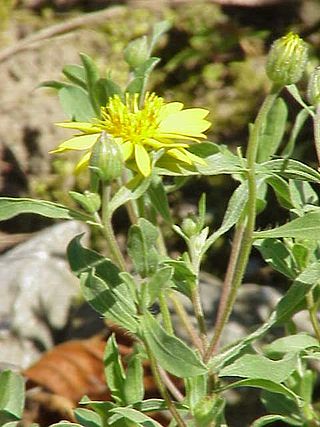
Ptelea trifoliata, commonly known as common hoptree, wafer ash, stinking ash, and skunk bush, is a species of flowering plant in the citrus family (Rutaceae). It is native to North America, where it is found in Canada, Mexico, and the United States. It is a deciduous shrub or tree, with alternate, trifoliate leaves.

Eriophyllum lanatum, with the common names common woolly sunflower, Oregon sunshine and golden yarrow, is a common, widespread, North American plant in the family Asteraceae.

Heterotheca is a genus of North American plants in the family Asteraceae.

Ericameria nauseosa, commonly known as chamisa, rubber rabbitbrush, and gray rabbitbrush, is a shrub in the sunflower family (Aster) found in the arid regions of western North America.

Heterotheca grandiflora is a species of flowering plant in the family Asteraceae known by the common name silk-grass goldenaster or telegraphweed. It is native to the southwestern United States and northwestern Mexico, but it can be found in other areas as an introduced species, such as Hawaii. It is often a roadside weed even where it is native.
Heterotheca oregona is a species of flowering plant in the family Asteraceae known by the common name Oregon false goldenaster. It is native to the west coast of Canada and the United States in British Columbia, Washington, Oregon, and California as far south as Los Angeles County.

Calochortus elegans is a species of flowering plant in the lily family known by the common name elegant Mariposa lily, cat's ear, elegant cat's ears or star tulip. It is native to the western United States from northern California to Montana.

Dieteria canescens is an annual plant or short lived perennial plant in the family Asteraceae, known by the common names hoary tansyaster and hoary-aster.

Heterotheca shevockii is a rare species of flowering plant in the family Asteraceae known by the common names Kern Canyon false goldenaster and Shevock's goldenaster. It is endemic to California in the United States, where it is known only from Kern County. It grows along a 21-mile stretch of the Kern River.

Bradburia pilosa, the soft goldenaster, is a North American species of flowering plants in the family Asteraceae, native to the south-central United States, primarily the southeastern Great Plains and lower Mississippi Valley, in the states of Texas, Oklahoma, Kansas, Missouri, Arkansas, Louisiana, Tennessee, Mississippi, and Alabama. Additional populations are reported farther east but these appear to be introductions. Its habitats include disturbed roadsides and pine-oak-juniper woods.

Erigeron subtrinervis, called the three-nerved daisy, the three-nerve fleabane, or the hairy showy daisy, is a North American species of flowering plants in the family Asteraceae. It grows in various mountains of western Canada and the western United States: Rocky Mountains, northern Cascades, Black Hills, etc., from British Columbia and Washington state east to North Dakota and south as far as New Mexico.

Heterotheca camporum, known by the common name lemonyellow false goldenaster, is a North American species of flowering plant in the family Asteraceae. It is found only in the central United States, primarily the Ozarks, the Cumberland Plateau, and the middle Mississippi Valley. There are reports of additional populations in the Northeast, the Southeast, and in the Great Lakes region, but these appear to be waifs or naturalizations.
Heterotheca barbata, the Spokane false goldenaster, is a very rare North American species of flowering plant in the family Asteraceae. It has been found only in the northwestern United States, in eastern Washington and northern Idaho.
Heterotheca fulcrata, known by the common name rockyscree false goldenaster, is a North American species of flowering plant in the family Asteraceae. It has been found in northern Mexico and in the western United States.

Heterotheca canescens, common name hoary goldenaster, is a North American species of flowering plant in the family Asteraceae. It has been found in northern Mexico and in the Great Plains of the central United States.

Heterotheca pumila, the alpine goldenaster, is a North American species of flowering plant in the family Asteraceae. It grows in alpine and subalpine regions in the mountains of the western United States. It has been found the Rocky Mountains in Wyoming, Colorado, Utah, and New Mexico.

Heterotheca rutteri, the Huachuca goldenaster or Rutter's false goldenaster, is a rare North American species of flowering plant in the family Asteraceae. It has been found only in the Huachuca and Santa Rita Mountains of southern Arizona and northern Sonora.

Heterotheca stenophylla, called the stiffleaf goldenaster, is a North American species of flowering plant in the family Asteraceae. It grows on the Great Plains of the central United States from South Dakota south to Texas and New Mexico.

Heterotheca viscida, called the cliff goldenaster, is a North American species of flowering plant in the family Asteraceae. It grows on cliffs and ledges in mountainous regions. It grows in the southwestern United States, primarily in Arizona, New Mexico and southern Texas with reports of isolated populations in Nevada, southeastern Idaho, and southeastern Colorado.

Heterotheca zionensis, the Zion goldenaster, is a North American species of flowering plant in the family Asteraceae. It grows in Utah, Arizona, New Mexico and western Texas. The plant has also reportedly been found in southeastern Idaho and northwestern Colorado, but these are most likely introductions.

















